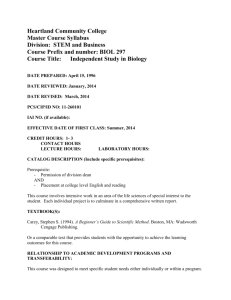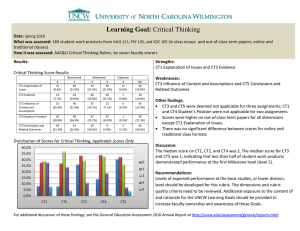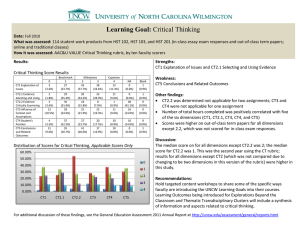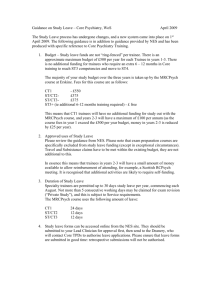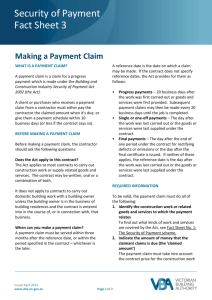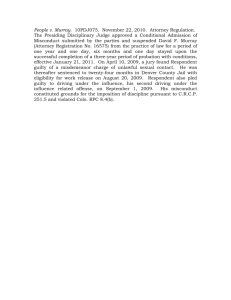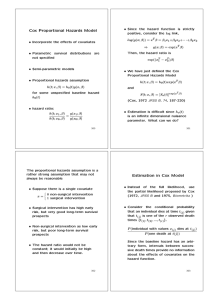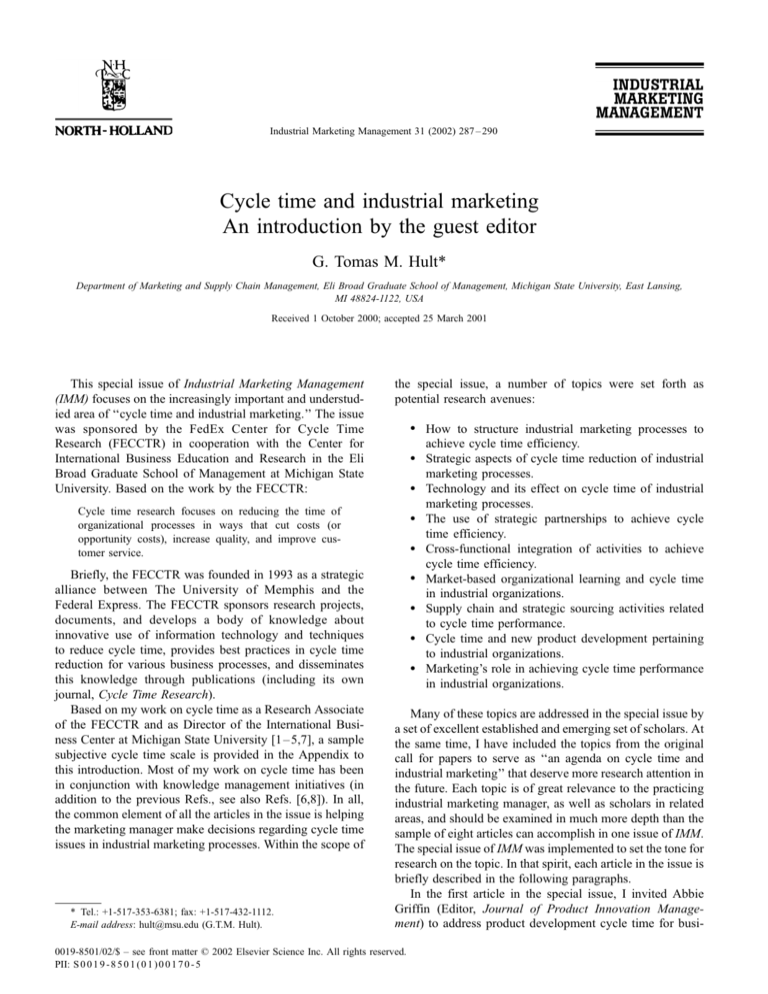
Industrial Marketing Management 31 (2002) 287 – 290
Cycle time and industrial marketing
An introduction by the guest editor
G. Tomas M. Hult*
Department of Marketing and Supply Chain Management, Eli Broad Graduate School of Management, Michigan State University, East Lansing,
MI 48824-1122, USA
Received 1 October 2000; accepted 25 March 2001
This special issue of Industrial Marketing Management
(IMM) focuses on the increasingly important and understudied area of ‘‘cycle time and industrial marketing.’’ The issue
was sponsored by the FedEx Center for Cycle Time
Research (FECCTR) in cooperation with the Center for
International Business Education and Research in the Eli
Broad Graduate School of Management at Michigan State
University. Based on the work by the FECCTR:
the special issue, a number of topics were set forth as
potential research avenues:
Cycle time research focuses on reducing the time of
organizational processes in ways that cut costs (or
opportunity costs), increase quality, and improve customer service.
Briefly, the FECCTR was founded in 1993 as a strategic
alliance between The University of Memphis and the
Federal Express. The FECCTR sponsors research projects,
documents, and develops a body of knowledge about
innovative use of information technology and techniques
to reduce cycle time, provides best practices in cycle time
reduction for various business processes, and disseminates
this knowledge through publications (including its own
journal, Cycle Time Research).
Based on my work on cycle time as a Research Associate
of the FECCTR and as Director of the International Business Center at Michigan State University [1– 5,7], a sample
subjective cycle time scale is provided in the Appendix to
this introduction. Most of my work on cycle time has been
in conjunction with knowledge management initiatives (in
addition to the previous Refs., see also Refs. [6,8]). In all,
the common element of all the articles in the issue is helping
the marketing manager make decisions regarding cycle time
issues in industrial marketing processes. Within the scope of
* Tel.: +1-517-353-6381; fax: +1-517-432-1112.
E-mail address: hult@msu.edu (G.T.M. Hult).
How to structure industrial marketing processes to
achieve cycle time efficiency.
Strategic aspects of cycle time reduction of industrial
marketing processes.
Technology and its effect on cycle time of industrial
marketing processes.
The use of strategic partnerships to achieve cycle
time efficiency.
Cross-functional integration of activities to achieve
cycle time efficiency.
Market-based organizational learning and cycle time
in industrial organizations.
Supply chain and strategic sourcing activities related
to cycle time performance.
Cycle time and new product development pertaining
to industrial organizations.
Marketing’s role in achieving cycle time performance
in industrial organizations.
Many of these topics are addressed in the special issue by
a set of excellent established and emerging set of scholars. At
the same time, I have included the topics from the original
call for papers to serve as ‘‘an agenda on cycle time and
industrial marketing’’ that deserve more research attention in
the future. Each topic is of great relevance to the practicing
industrial marketing manager, as well as scholars in related
areas, and should be examined in much more depth than the
sample of eight articles can accomplish in one issue of IMM.
The special issue of IMM was implemented to set the tone for
research on the topic. In that spirit, each article in the issue is
briefly described in the following paragraphs.
In the first article in the special issue, I invited Abbie
Griffin (Editor, Journal of Product Innovation Management) to address product development cycle time for busi-
0019-8501/02/$ – see front matter D 2002 Elsevier Science Inc. All rights reserved.
PII: S 0 0 1 9 - 8 5 0 1 ( 0 1 ) 0 0 1 7 0 - 5
288
G.T.M. Hult / Industrial Marketing Management 31 (2002) 287–290
ness-to-business products. As an Editor of JPIM and
researcher on cycle time issues, Griffin communicates some
very interesting information related to the absolute cycle
time of product development. Specifically, she uses data
from the Product Development and Management Association’s Best Practices research to quantify average cycle
times for physical goods commercialized by B2B firms.
In the second article, Dan Flint continues the special
issue’s focus on product development by conceptually examining how firms can improve the probability of new product
success and also speed up the process of doing so. Grounded
in his work for numerous small and large corporations, Flint
proposes a logical and pragmatic framework on how to keep
up with changes in what a key customer values, understanding the new product ideation process, and understanding what
customers value and how it changes. Of the seven competitively reviewed articles in the special issue, Dan Flint’s paper
was rewarded with the FECCTR Best Paper Award for
‘‘outstanding contribution to scholarly research and managerial practice on cycle time reduction initiatives.’’
The remaining six articles examine a wide variety of
important cycle time issues. Menon, Chowdhury, and Lukas
examine the antecedents and outcomes of new product
development speed. Bashaw, Ingram, and Keillor examine
sales training cycle time for new trainees. Davis, Dibrell,
and Janz study the impact of time on the strategy –performance relationship. Lukas, Menon, and Bell report results of a
study on product development speed and organizational
stress. Gardiner, Hanna, and LaTour present a study on
ERP and the reengineering of industrial marketing. Finally,
Handfield and Bechtel examine the role of trust and relationship structure in improving supply chain responsiveness.
I hope you enjoy the issue!
CT3
CT4
CT5
CT6
Appendix A. The Cycle Time (CT) scale
Item
CT1
CT2
Description
The length of the supply chain process is
getting shorter every time. Because the
primary focus of cycle time performance
is the reduction in time it takes from
initiation to completion of an organizational
process, the objective of this item is to
assess the respondent’s sense of
consistent and constant reduction in cycle
time. The foundation rationale for the
item is that the reduction in cycle time
is an ongoing systematic process
that never ends. Improvements can
always be made to the existing process.
We have seen an improvement in the
cycle time of the supply chain process
recently. While item CT1 addresses the
continuous reduction in cycle time, item
CT2 measures the cycle time reduction
CT7
based on a time definite interval.
Commonly, organizations evaluate their
operating behaviors at certain points
in time.
We are satisfied with the speediness of the
supply chain process . Item CT3 measures
the cycle time based on the respondent’s
experience with the organizational process.
As such, item CT3 incorporates ‘‘speed’’
as a qualifier to the respondent’s level of
satisfaction with the cycle time.
Involving all the participants in
decision-making shortens the supply
chain process. Item CT4 focuses on the
cycle time improvements that may be
made if all of the participants involved
throughout the process were a part of the
decision-making activities pertaining to
the process.
The length of the supply chain process
can be shortened by involving all of the
participants in the process. Item CT5
addresses the total cycle time of the
organizational process, as opposed to
examining specific parts of the process,
as is the focus of items CT3 and CT4.
Thus, item CT5 can be interpreted to
mean that involving all of the supply
chain participants in at least some parts
of the process will reduce the total cycle
time of the process.
Compared with the ‘‘old’’ supply chain
process, the ‘‘new’’ supply chain process
involving all the participants is faster.
While item CT1 addresses the
continuous reduction in cycle time and
item CT2 measures the cycle time
reduction based on a time definite
interval, the intention of item CT6 is to
assess cycle time improvements over
a longer time period – after structural
changes have been implemented to
involve all of the participants in the
process more directly.
Based on our knowledge of the
supply chain process, we think it is short
and efficient. Item CT7 asks the respondent
to provide their perceptions of the cycle
time of the organizational process based
on their knowledge of the activities
that have to be performed to complete
the process. As such, item CT7
provides the respondent a direct
opportunity to voice their opinion
on the cycle time of the organizational
process incorporating

